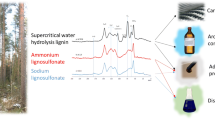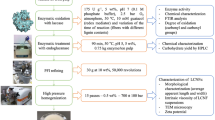Abstract
Lignins from the spent pulping liquor were normally acquired as waste product of pulp and paper mills. The possibilities of utilizing kraft lignin have yet been developed for commercial innovation. The objectives of this research are to recovery and utilization of lignin from black liquor of oil palm empty fruit bunches (OPEFBs). Kraft lignins from the OPEFBs black liquor were recovered by acidification procedure. They were precipitated at pH 4, 3, and 2 in order that determine the optimum pH for isolation. It can be clearly seen that the best condition of lignin precipitation was at pH 3. It offered the highest yield and purity. The kraft lignin and agarose were utilized as the crude material for the production of lignin–agarose hydrogel. Lignin–agarose hydrogel could be prepared by using epichlorohydrin as the cross-linking agent. The cross-linking occurrence was recognized by FTIR. Physical and chemical properties of hydrogel were investigated. Gel strength of lignin–agarose hydrogel was characterized by texture personal analysis. The results demonstrated that the gel strength increased with increasing of lignin and epichlorohydrin (ECH) in agarose solutions. 5% lignin, 5% agarose and 10 mL ECH contributed the best gel formation and the great mechanical properties. The effect of cross-linking condition on the gel properties, for example, gel hardness and fracturability, was examined.




Similar content being viewed by others
References
Alén R, MânVu TP, Pakkanen H (2003) Delignification of bamboo (Bambusa procera acher): part 1. Kraft pulping and the subsequent oxygen delignification to pulp with a low kappa number. Ind Crops Prod 19(1):47–57
Theliander H (2007) Recovery of cooking chemicals; the treatment and burning of black liquor. Ljungberg textbook, pulp and paper chemistry and technology, book 2, pulping chemistry and technology ed(s), fiber and polymer technology. KTH, Stockholm
Wallberg O, Jönsson AS, Wimmerstedt R (2003) Ultrafiltration of kraft black liquor with a ceramic membrane. Desalination 156:145–153
Lora JH, Glasser WG (2002) Recent industrial applications of lignin: a sustainable alternative to nonrenewable materials. J Polym Environ 10(1–2):39–48
Domenek S, Louaifi A, Guinault A, Baumberger S (2013) Potential of lignins as antioxidant additive in active biodegradable packaging materials. J Polym Environ 21(3):692–701
Sun RC, Tomkinson J, Bolton J (1999) Effects of precipitation pH on the physicchemical properties of the lignins isolated from the black liquor of oil palm empty fruit bunch fiber pulping. Polym Degrad Stab 63:195–200
Grishechko LI, Labat A, Fierro V, Kuznetsov BN, Pizzi A, Celzard A (2013) Tannin-based xerogels with distinctive porous structures. Ind Crops Prod 43:347–355
Hofrichter M, Steinbuchel A (2001) Lignin, humic substances and coal. Biopolymer 1:89–127
Martin BC, Minner EJ, Wiseman SL, Klank RL, Gilbert RJ (2008) Agarose and methylcellulose hydrogel blends for nerve regeneration applications. J Neural Eng 5:221–231
Ma Y, Lv L, Guo Y, Fu Y, Shao Q, Wu T, Guo S, Sun K, Guo X, Wujcik EK, Guo Z (2017) Porous lignin based poly (acrylic acid)/organo-montmorillonite nanocomposites: swelling behaviors and rapid removal of Pb(II) ions. Polymer 128:12–23
Cheng XQ, Wang ZX, Jiang X, Li T, Lau CH, Guo Zh, Ma J, Shao L (2018) Towards sustainable ultrafast molecular-separation membranes: from conventional polymers to emerging materials. Prog Mater Sci 92:258–283
Cao Z, Gilbert RJ, He W (2009) Simple agarose–chitosan gel composite system for enhanced neuronal growth in three dimensions. Biomacromology 10:2954–2959
Mano J, Silva G, Azevedo HS, Malafaya P, Sousa R, Silva S, Boesel L, Oliveira JM, Santos T, Marques A (2007) Natural origin biodegradable systems in tissue engineering and regenerative medicine: present status and some moving trends. J R Soc Interface 4(17):999–1030
Sun Y, Wei J, Wang YS, Yang G, Zhang JP (2010) Production of activated carbon by K2CO3 activation treatment of cornstalk lignin and its performance in removing phenol and subsequent bioregeneration. Environ Technol 31(1):53–61
Saake B, Lehnen R (2007) Size-exclusion chromatography of technical lignins in dimethyl sulfoxide/water and dimethylacetamide. J Chromatogr A 1102:154–163
Trivedi TJ, Rao KS, Kumar A (2014) Facile preparation of agarose–chitosan hybrid materials and nanocomposite ionogels using an ionic liquid viadissolution, regeneration and sol–gel transition. Green Chem 16(1):320–330
Varoni E, Tschon M, Palazzo B, Martini L, Rimondini L (2012) Agarosegel as biomaterial or scaffold for implantation surgery: characterization, histological and histomorphometric study on soft tissue response. Connect Tissue Res 53(6):548–554
Kubo S, Kadla JF (2005) Lignin-based carbon fibers: effect of synthetic polymer blending on fiber properties. J Polym Environ 13(2):97–105
Zhao M, Meng L, Ma L, Ma L, Yang X, Huang Y, Ryu JE, Shankar A, Li T, Yan C, Guo Z (2018) Layer-by-layer grafting CNTs onto carbon fibers surface for enhancing the interfacial properties of epoxy resin composites. Compos Sci Technol 154:28–36
Musilová L, Mráček A, Kovalcik A, Smolka P, Minařík A, Humpolíček P, Vícha R, Ponížil P (2018) Hyaluronan hydrogels modified by glycinated Kraft lignin: morphology, swelling, viscoelastic properties and biocompatibility. Carbohydr Polym 181:394–403
Su Y, Liu J, Yue Q, Li Q, Gao B (2014) Adsorption of ammonium and phosphate by feather protein based semi-interpenetrating polymer networks hydrogel as a controlled-release fertilizer. Environ Technol 35(4):446–455
Millán AJ, Nieto MI, Moreno R, Baudin C (2002) Thermogelling polysaccharides for aqueous gel casting-part I: a comparative study of gelling additives. J Eur Ceram Soc 22:2209–2215
Gómez LG, Méndez JA, Fernández M, Vázquez B, Román JS (2014) Oxidized dextrins as alternative cross-linking agents for polysaccharides: application to hydrogels of agarose–chitosan. Acta Biomater 10(2):798–811
Gřundělová L, Gregorova A, Mráček A, Vícha R, Smolka P, Minařík A (2015) Viscoelastic and mechanical properties of hyaluronan films andhydrogels modified by carbodiimide. Carbohyd Polym 119:142–148
Yamada Y, Hozumi K, Aso A, Hotta A, Toma K, Katagiri F (2012) Laminin active peptide/agarose matrices as multifunctional biomaterials for tissue engineering. Biomaterials 33:4118–4125
De Rosa E, Urciuolo F, Borselli C, Gerbasio D, Imparato G, Netti PA (2016) Time and space evolution of transport properties in agarose–chondrocyte constructs. J Tissue Eng 12:2193–2201
Lin J, Chen XY, Chen CY, Hu JT, Zhou C, Cai XF, Zheng Ch, Zhang PP, Cheng J, Guo Z (2018) Durably antibacterial and bacterially anti-adhesive cotton fabrics coated by cationic fluorinated polymers. ACS Appl Mater Interfaces. https://doi.org/10.1021/acsami.7b16235
Cui XK, Zhu G, Pan Y, Shao Q, Zhao Z, Dong M, Zhang Y, Guo Z (2018) Polydimethylsiloxane–titania nanocomposite coating: fabrication and corrosion resistance. Polymer. https://doi.org/10.1016/j.polymer.2018.01.063
Lindenbaum ES, Tendler M, Beach D (1995) Serum-free cell culture medium induces acceleration of wound healing in guinea-pigs. Burns 21:110–115
Narapakdeesakul D, Sridach W, Wittaya T (2013) Novel use of oil palm empty fruit bunch’s lignin derivatives for production of linerboard coating. Prog Org Coat 76:999–1005
Jun A, Tschirner UW, Tauer Z (2012) Hemicellulose extraction from aspen chips prior to kraft pulping utilizing kraft white liquor. Biomass Bioenerg 37:229–236
Baharuddin AS, Sulaiman A, Kim DH, Hassan MN, Wakisaka M, Shirai Y, Nishida H (2013) Selective component degradation of oil palm empty fruit bunches (OPEFB) using high-pressure steam. Biomass Bioenerg 55:268–275
Rohella RS, Sahoo N, Paul SC, Choudhury S, Chakravortty V (1996) Thermal studies on isolated and purified lignin. Thermochim Acta 287:131–138
Farag S, Mudraboyina BP, Jessop PG, Chaouki J (2016) Impact of the heating mechanism on the yield and composition of bio-oil from pyrolysis of kraft lignin. Biomass Bioenerg 95:344–353
Fukushima RS, Kerley MS, Ramos MS, Porter JH, Kallenbach RL (2015) Comparison of acetyl bromide lignin with acid detergent lignin and Klason lignin and correlation with in vitro forage degradability. Anim Feed Sci Technol 201:25–37
TAPPI: T222-om-02. Technical Association of the Pulp and Paper Industry 1983 (reaffirmation in 2006)
Methacanon P, Krongsin J, Gamonpilas C (2014) Pomelo (Citrus maxima) pectin: effects of extraction parameters and its properties. Food Hydrocoll 35:383–391
Garcia A, Toledano A, Serrano L, Egues I, Gonzalez M, Marin F, Labid J (2009) Characterization of lignins obtained by selective precipitation. Sep Purif Technol 68:193–198
Hurler J, Engesland A, Kermany BP, Škalko-Basnet N (2012) Improved texture analysis for hydrogel characterization: gel cohesiveness, adhesiveness, and hardness. J Appl Polym Sci 125:180–188
Bai YX, Li YF (2006) Preparation and characterization of cross linked porous cellulose beads. Carbohydr Polym 64:402–407
Chang C, Lue A, Zhang L (2008) Effects of cross-linking methods on structure and properties of cellulose/PVA hydrogels. Macromol Chem Phys 209:1266–1273
Denizli BK, Can HK, Rzaev ZMO, Guner A (2004) Preparation conditions and swelling equilibria of dextran hydrogels prepared by some crosslinked agents. Polymer 45(19):6431–6435
Ciolacu D, Kovac J, Kokol V (2010) The effect of the cellulose-binding domain from Clostridium cellulovorans on the supramolecular structure of cellulose fibers. Carbohyd Res 345:621–630
Gwartney EA, Larick DK, Foegeding EA (2004) Sensory texture and mechanical properties of stranded and particulate whey protein emulsion gels. J Food Sci 69:5333–5339
Barrangou LM, Daubert CR, Foegeding EA (2006) Textural properties of agarose gels. II. Relationships between rheological properties and sensory texture. Food Hydrocoll 20:184–195
Ciolacu D, Oprea AN, Anghel N, Cazacu G, Cazacu M (2012) New cellulose–lignin hydrogels and their application in controlled release of polyphenols. Mater Sci Eng 32:452–463
Hergert HL, Kurth EF (1953) The infrared spectra of lignin and related compounds. I. Characteristic carbonyl and hydroxyl frequencies of some flavanones, flavones, chalcones and acetophenones. J Am Chem Soc 75:1622–1625
Sarkanen KV, Chang HM, Ericsson B (1967) Species variation in lignins I infrared spectra of guaiacyl and syringyl models. Tappi 50(11):572–575
Oh SY, Yoo DI, Shin Y, Kim HC, Kim HY, Chung YS (2005) Crystalline structure analysis of cellulose treated with sodium hydroxide and carbon dioxide by means of X-ray diffraction and FTIR spectroscopy. Carbohyd Res 340:2376–2391
Duri RA, Lynch BM, Sternhell S (1960) Comparative studies of brown coal and lignin. I. Infra-red spectra. Aust J Chem 13:156–165
Socrates G (2004) Organic halogen compounds. In: Infrared and Raman characteristic group frequencies: tables and charts, 3rd edn. Wiley, Chichester, pp 198–208
Raschip IE, Hitruc GE, Vasile C, Popescu MC (2007) Semi interpenetrating polymer networks containing polysaccharides. I. Xanthan/lignin networks. High Perform Polym 19:603–620
Acknowledgements
The authors are extremely grateful to the Graduate School at Prince of Songkla University, the Office of the Higher Educations Commission at the Ministry of Education and Yala Rajaphat University (YRU) for financial support.
Author information
Authors and Affiliations
Corresponding author
Rights and permissions
About this article
Cite this article
Sathawong, S., Sridach, W. & Techato, Ka. Recovery of Kraft Lignin from OPEFB and Using for Lignin–Agarose Hydrogel. J Polym Environ 26, 3307–3315 (2018). https://doi.org/10.1007/s10924-018-1218-3
Published:
Issue Date:
DOI: https://doi.org/10.1007/s10924-018-1218-3




